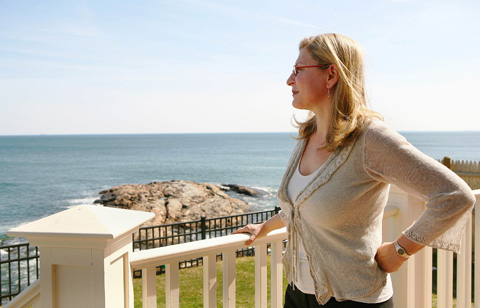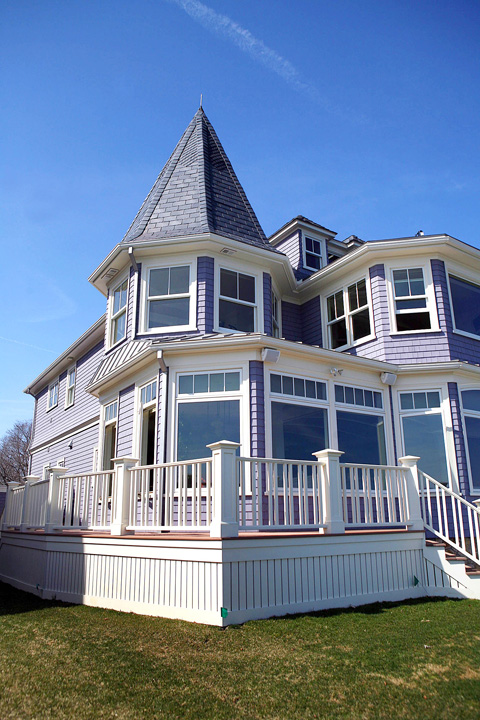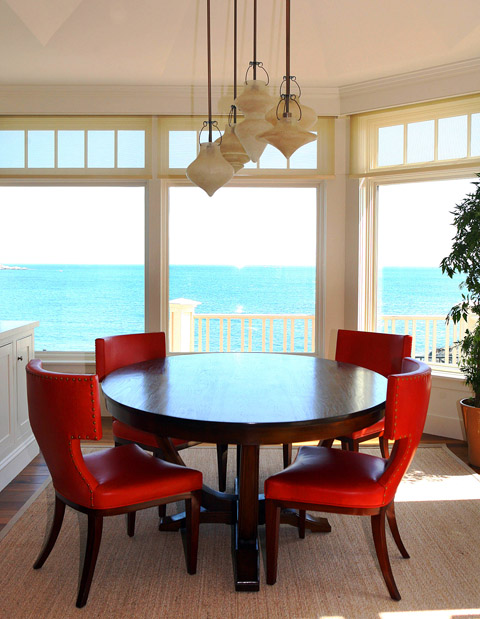Barbara Goldman is no garden-variety environmentalist. When she rehabbed her luxury ocean-front home recently, she insisted that it be eco-sensitive from the basement to the rooftop.
That’s not an easy assignment when green supplies typically cost more and can be harder to find. But Goldman was not deterred.
Consider her roof (recycled rubber), her kitchen counter (Silestone) and her floors (a domestic walnut harvested from old trees that were about to die). Her Bosch washing machine, depending on the load, can use a mere eight liters of water. Her pipes are cast iron, not plastic.

PHOTO: NY Times News Service
“I don’t claim to be a purist,” said Goldman, a 45-year-old attorney. “I don’t eat all organic. I still wear nail polish. I’ve just chosen one area of my life, my house, to make a difference. If we can be an example for other projects, that’s a great thing.”
Eco-friendly construction materials, from solar energy to recycled wood, have been buzzwords since the 1970s. But until recently, green building has been most popular on the commercial level, not so much on the residential side. “There’s more opportunity for saving resources when you’re dealing with a 50-story office tower than a single home,” said Paul Marquis, education coordinator for the NEXUS Green Building Resource Center in Boston, a project of the nonprofit Green Roundtable.
But with today’s rising energy costs and environmental concerns, the residential market is coming around.

PHOTO: NY TIMES NEWS SERVICE
“In the past six months, interest in green residential homes has really taken off,” said Marquis, who has seen 5,000 visitors come to view green samples at his Downtown Crossing reference library since it opened in February 2007. “The market drivers are the soaring costs of energy and a recognition that global warming is a problem we need to address.”
For the first time last fall, the nonprofit US Green Building Council established LEED certification (leadership in energy and environmental design) for residential homes. The national rating system for green building design and construction has been in place for commercial spaces since 2000.
To date, there are 548 LEED-certified homes in the US, including 19 in the state of Massachusetts.

PHOTO: NY TIMES NEWS SERVICE
Goldman, whose home just received its LEED certification, began the gut renovation of her home shortly after she and her husband purchased their 138-year-old, three-bedroom Victorian home in August of 2005. The 600m2 house, which has five bathrooms and an elevator, overlooks the ocean.
Goldman’s top priorities were energy efficiency and indoor air quality. “It was important for us, if we were going to be on the water, that we felt warm. The previous owners completely obscured their view. The windows were covered and it was dark. In my opinion, it was because it was so cold in here.”
Given rising energy costs, the couple pulled out the existing electrical and heating systems. “We figured how could we not explore alternative energy?” she said.
What followed was quite an exploration. She settled on a geothermal heating system, which meant drilling two 150m wells in the yard. The heating system has six zones so only the occupied sections of the house are heated. A radiant heating system warms the first floor. The walls are insulated with Icynene (a foam insulation that is applied as a liquid and then expands to fill every crevice).
Goldman’s insistence on indoor air quality got her thinking about the chemicals in the paint she was using, the glue in the kitchen cabinetry, the varnishes on the floors, and the upholstery on her furniture.
“I am a breast cancer survivor,” said Goldman. “I started thinking that if we were insulating the house well, my system might be assaulted by all sorts of chemicals that we were bringing in. So I started asking questions about every single thing I was purchasing.”
After meeting with several architecture and interior design firms, Goldman enlisted the help of Boston-based Heather G. Wells. “I wanted a team approach and she could provide that,” Goldman said. “We were operating on two tracks simultaneously, the architecture and the interior design.”
The project was a challenge for the firm, which had never before attempted to make a residential home LEED certified. “Everything we touched we had to give some thought to,” said Wells, an architect and interior designer.
“We used a lot of our normal vendors but we needed to talk to them about it,” she said. “We had to ask: ‘What’s in this?’ They didn’t even know. It’s not on everybody’s consciousness yet. There’s stuff out there. You just have to push people.”
Janine Dowling, an interior designer for Wells, said she did much of her research for the project on the Internet on sites such as carpet-rug.org, whitelotus.net and staplescabinetmakers.com.
“I had to educate myself. What are the worst offenders in a house for VOCs [volatile organic compounds that can vaporize and enter an atmosphere]?” she said. “Paint, carpeting, and mattresses. Many mattresses are sprayed with formaldehyde as a fire retardant. Carpeting can be coated in toxins. And we are so used to having the benefits of chemicals in our paint finishes.”
The team turned to Benjamin Moore’s low-VOC Aura line for paint. It also used the water-based glaze Glacis by Adicolor for cabinets in the master bedroom closet, a bathroom and mudroom. In Goldman’s two teenage boys’ bedrooms, she used Flor carpet tiles made of natural fibers. To polish up her walnut floors, she used tung oil as a stain.
Despite her best green efforts, Goldman wasn’t always successful. The Wells team, for example, was not able to find purple organic mohair for the sofas in the living room at a reasonable price.
“We shopped every vendor looking for the particular shade she wanted,” Dowling said. “We could not match what she wanted in her head. When it comes to the tippy-top high end, it’s hard to find a green line. Chemicals add a lot of stability in color. As far as I know, there aren’t any sustainable mohairs yet.”
Dowling could have had it made, she added, but it would have cost about US$400 a meter. They needed roughly 40m of fabric. Instead, the team settled on regular mohair, which cost about US$70 a meter. “You can’t control everything,” she said.
Goldman, who moved into the home in December, couldn’t be happier. “I am very proud of the way the house has come out,” she said. “It smells good. It feels good.”
Not everyone is impressed with projects like Goldman’s. Paul Eldrenkamp, president of Byggmeister, a remodeling contractor in Newton, Massachusetts, said consumers need to be careful about how they define green.
“Any 6,000-square-foot house [560 m2] is going to be a light shade of green. It’s too big to be efficient,” said Eldrenkamp, who has not seen the Goldman house.
Green features like a deck made of recycled materials or bathroom floors made of natural stone are nice, he said, but 20 years from now energy consumption will have the most environmental impact. “From a carbon footprint perspective, it’s most important to minimize the costs required to heat and cool a house,” he said.
Still, Goldman says all winter her family only used the first floor’s radiant heating system to warm the entire house. They never turned on the geo-thermal blowers. “We were very comfortable,” she said.
For all her efforts, Goldman doesn’t expect everyone to go as green as she has. “Since everything in my home was going to be new and fresh, I figured I had an opportunity,” she said. “Everybody has to do what they feel comfortable doing. It is a process.”

May 26 to June 1 When the Qing Dynasty first took control over many parts of Taiwan in 1684, it roughly continued the Kingdom of Tungning’s administrative borders (see below), setting up one prefecture and three counties. The actual area of control covered today’s Chiayi, Tainan and Kaohsiung. The administrative center was in Taiwan Prefecture, in today’s Tainan. But as Han settlement expanded and due to rebellions and other international incidents, the administrative units became more complex. By the time Taiwan became a province of the Qing in 1887, there were three prefectures, eleven counties, three subprefectures and one directly-administered prefecture, with

It’s an enormous dome of colorful glass, something between the Sistine Chapel and a Marc Chagall fresco. And yet, it’s just a subway station. Formosa Boulevard is the heart of Kaohsiung’s mass transit system. In metro terms, it’s modest: the only transfer station in a network with just two lines. But it’s a landmark nonetheless: a civic space that serves as much more than a point of transit. On a hot Sunday, the corridors and vast halls are filled with a market selling everything from second-hand clothes to toys and house decorations. It’s just one of the many events the station hosts,

Two moves show Taichung Mayor Lu Shiow-yen (盧秀燕) is gunning for Chinese Nationalist Party (KMT) party chair and the 2028 presidential election. Technically, these are not yet “officially” official, but by the rules of Taiwan politics, she is now on the dance floor. Earlier this month Lu confirmed in an interview in Japan’s Nikkei that she was considering running for KMT chair. This is not new news, but according to reports from her camp she previously was still considering the case for and against running. By choosing a respected, international news outlet, she declared it to the world. While the outside world

Through art and storytelling, La Benida Hui empowers children to become environmental heroes, using everything from SpongeBob to microorganisms to reimagine their relationship with nature. “I tell the students that they have superpowers. It needs to be emphasized that their choices can make a difference,” says Hui, an environmental artist and education specialist. For her second year as Badou Elementary’s artist in residence, Hui leads creative lessons on environmental protection, where students reflect on their relationship with nature and transform beach waste into artworks. Standing in lush green hills overlooking the ocean with land extending into the intertidal zone, the school in Keelung